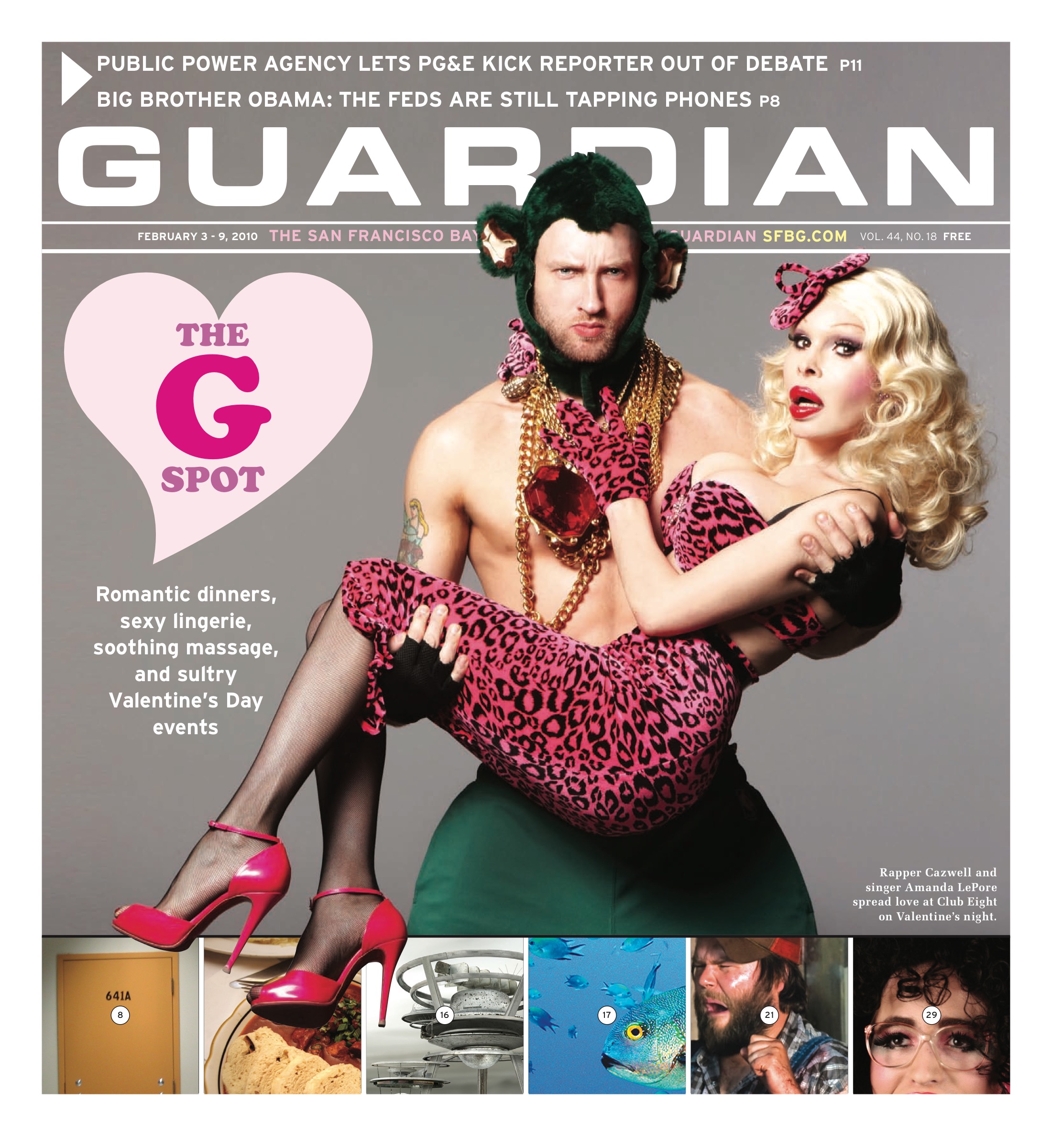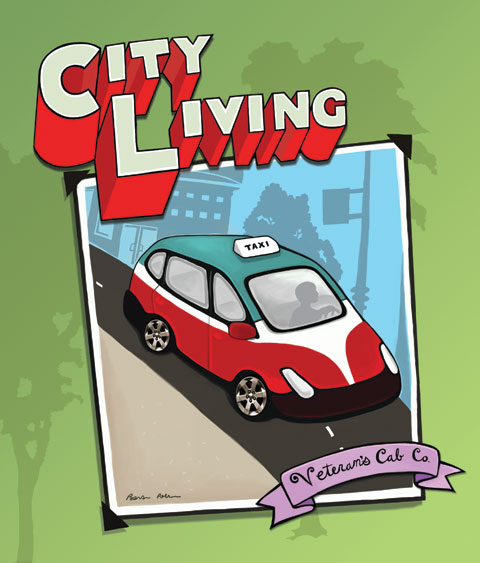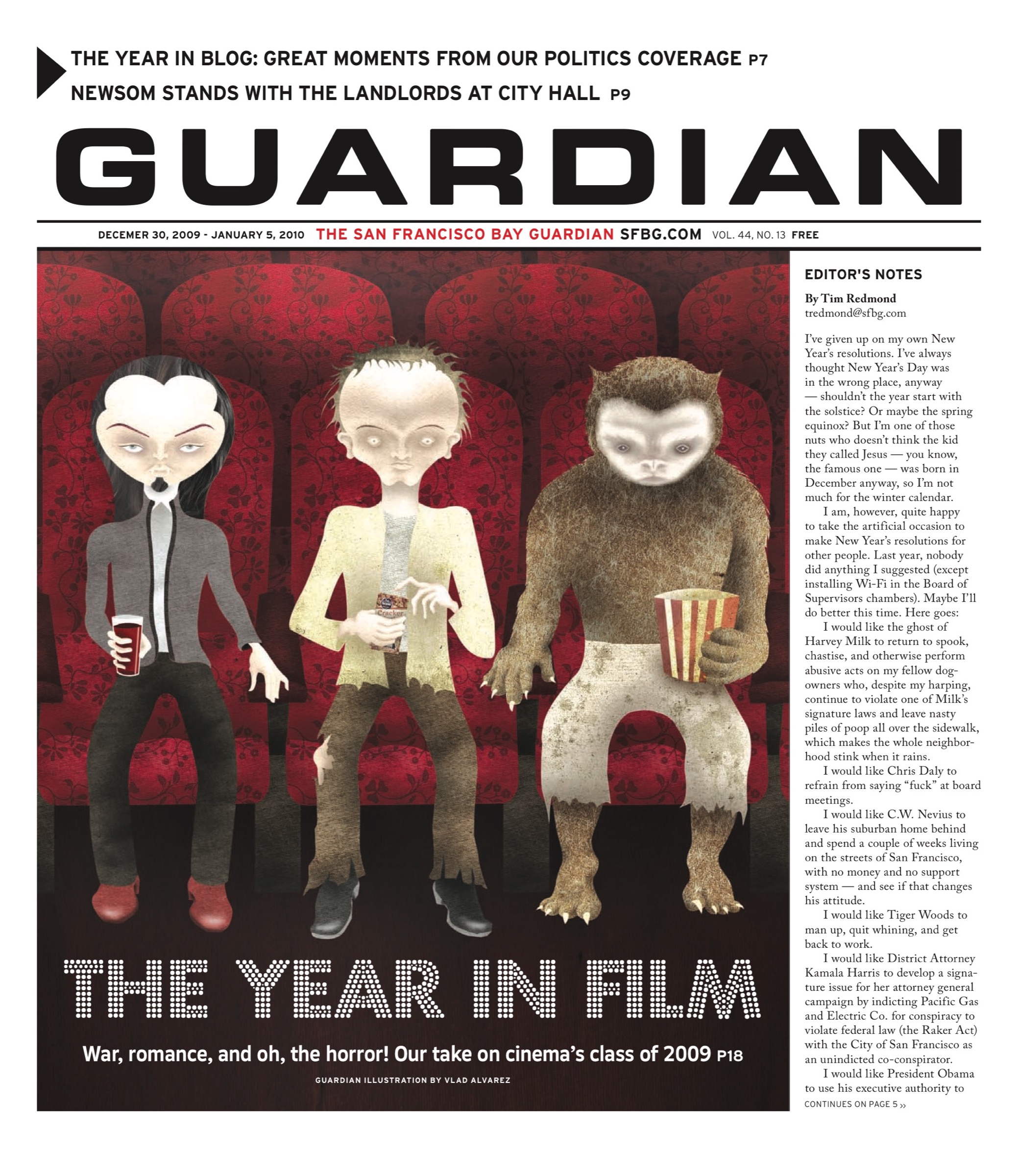Editors Picks: City Living
BEST ALTERNATIVE REALITY
Looking to join a cult, but don’t want to deal with the bothersome side effects, like painful indoctrination, induced dependency, and mass suicide? Participate in a fake cult: it’s just like a real cult, without the satanic ritual abuse! Jejune isn’t just an arcane word used in David Foster Wallace novels — it’s also the name of the most mysterious fake cult in San Francisco, centered around a fictitious man known as Octavio Coleman. Coleman supposedly started the Jejune Institute in 1973 as a “center for socio-reengineering,” and claims to have invented products such as a camera that takes pictures of the past, a process of transferring memories onto VHS tapes, and a method of engaging in telepathy with dolphins. Whatever its origins, the Jejune Institute is now the workings of an artist collective that stages elaborate alternative reality games (and generates related mind-screwing posters and fliers) out of its office in the Financial District. Join the Jejune, suspend your disbelief, and revel in the bizarreness.
580 California, Suite 1607, SF. (415) 325-4014, www.jejuneinstitute.com
BEST HOTEL GONE POKÉMON
City leaders pondering how to revitalize the languishing Japantown neighborhood need look no further than the hallucinatory wonder that is Hotel Tomo. Snazzy boutique-hotel renovationist corp Joie de Vivre has transformed this former dull Best Western into a super-sleek sleepover spot evoking all of the anime vibrance and digital modernism of Japanese culture. Manga murals bedeck the beautifully refurnished wooden interior, and Giant Robot vending machines, free Wi-fi, and iPod docking stations are among the many perks for hotel guests. For special occasions, there are two gaming suites, with six-foot-long LCD screens for enthralling marathon Wii, Sony PS3, or Nintendo sessions. Guests with a Godzilla-size appetite should make their way to Tomo’s in-house eatery, Mums restaurant and bar, which specializes in all-you-can-eat shabu-shabu. With Tomo’s reasonable rates, kids and kids-at-heart can dig the J-pop accoutrements and indulge their playful sides all night long.
1800 Sutter, SF. (415) 921-4000
BEST AWWW-INSPIRING CHARITY
Homeless kids lack a lot of things, and security is on the top of the list. Every night can mean a different place — a shelter, someone’s floor, a bus station, the street. And while Project Night Night can’t and doesn’t try to solve all the problems of homeless kids and families, the group does something that has real psychological importance: volunteers hand out bags that contain a stuffed animal, a soft blanket, and an age-appropriate book. That means when the kids go to bed, they’ve got something to hold onto. It’s a little thing — but in the life of a five-year-old, a little security goes a long way. Kendra Stitt Robins launched the San Francisco-<\d>based nonprofit in 2005, after beginning to raise her own child and fully realizing the value of small comforts. Per year, Project Night Night has given out more than 25,000 care packages nationwide, many of which wouldn’t be possible without donations.
1800 Gough, Suite 5, SF. (415) 310-0360, www.projectnightnight.org
BEST VIRTUAL MISSION
Politics! Culture! Real-time crime reports! Drunken hipsters! Whether you want to immerse yourself in the gory and dramatic details of the proposed American Apparel store, suss out the latest renegade Sparks-and-empanada-flavored ice cream food cart location, revel in random pics of burnt mattresses on the sidewalk, or mock the Ritual Roasters laptop rodeo, of course you turn to the Mission Mission blog, our one-click West Coast answer to Brooklyn Vegan, Hipster Runoff, and Lookbook. (Forget Williamsburg, chumps, if you haven’t already — the Mission does scruffy, authenticity-obsessed gentrification better than anyone else.) Nothing is safe from the Mission Mission crew — no new bar, no new bar sign, no new bar sign misspelling, no photo essay of said new bar sign being made from recycled hemp shoes and licorice drops by quirky Malaysian immigrant artists. In fact, Mission Mission is so comprehensive, you might never have to visit the neighborhood again, which could be the point.
missionmission.wordpress.com
BEST HEALTHY EXCLAMATION
If you require a massage to heal and realign from the last time you fell off your bike, or just want to talk to someone about why you have a strange rash or unwarranted fatigue, Be Whole Again! nutrition and wellness studio can offer a restorative path to feeling better. Through craniosacral and massage therapy and herbal nutritional supplements, owner and main practitioner Carolynn Kraskouskas works with your problem — rather than fighting it. She employs light touches to enhance the functioning of the central nervous system, which relieves tension, aligns the body, and even makes it more resistant to disease. Kraskouskas also examines your habitual behaviors — like the way you sit, stand, and walk — so that you have to the option of taking control over some aspects of your wellness. More importantly, she is realistic and willing to work with your lifestyle without being judgmental.
3150 18th St., Suite 536, SF. (415) 846-3640, www.bewholeagain.net
BEST SHOP THAT SUCKS IN A GOOD WAY
Having carpet in your apartment or house is awesome because it enables you to do all sorts of things that hardwood floors just don’t. You can do yoga without a mat. You can go barefoot without freezing. And you can make sweet, spontaneous love on it without getting splinters up the wazoo (watch that rugburn, though!). The only bad thing about carpet, unless your plush is ultra-tacky, is that it requires a vacuum to clean, and a vacuum can suffer from many more perplexing technical problems than its analog counterpart, the broom. What to do when your hose starts smoking, your fan belt melts, or your HEPA belches week-old cat fur? Roll that sucker over to the Hoover Company, a full-service vacuum repair and sales shop in the Richmond. The welcoming and straight-talking staff will spiff your vac right up at a low cost, teach you how to prevent clogs, sell you something new if you need it, and even refer you to other places to pick up parts.
3628 Geary, SF. (415) 668-5101
BEST NEWS WITH A BAY VIEW
Do you read about Oscar Grant, hear about racist predatory lenders, see large numbers of black folks migrating away from San Francisco — and feel powerless to do anything? Read in the San Francisco Bay View newspaper how people are fighting back around the Bay, across the country, and throughout the world. “All this pressure, and we’re still here,” says editor Mary Ratcliff about the paper’s Bayview neighborhood, pointing out that polluting developer Lennar has yet to build even one promised home there or Hunters Point. “Police with tanks, helicopters, a crime lab in the neighborhood … we went up against Home Depot, the Navy — and in most cases, we have won.” The Bay View‘s not removed from the issues it reports on: last year the paper went from a weekly to a monthly print edition, surviving foreclosure on its offices after struggling with predatory loans for years. Its Web site has stayed packed with articles through it all.
4917 Third St., SF. (415) 671-0789, www.sfbayview.com
BEST MARINA FLUFF (AND FOLD)
One of the worst things about living in an old NorCal city is that you’re constantly faced with hardships people in SoCal’s cookie-cutter, overdeveloped towns never even think about: public transportation, bed bugs, creaky floors, and, worst of all, laundry. While apartment buildings in L.A. and San Diego commonly feature in-house facilities, we’re often stuck using Laundromats. Which means that every week we have to stuff our soiled clothing in bags, truck our pile down the street, and then sit and wait until it’s done. It’s pretty much the most boring shit ever, but you can minimize the pain of apparel maintenance if you know where to go. For people near the Marina, that place is the cheekily named Greenwich Clean Time. It’s got one of the fastest washer-dryer setups in town, and its fluff-and-fold service is famously inexpensive and thorough. Also, unlike most Laundromats, this one’s squeaky clean. Greenwich Clean Time might not keep you from fantasizing about the pre-packaged ease of life down south, but it might stop you from actually moving there. The horror!
1720 Greenwich, SF. (415) 474-6972
BEST TOOL FOR THE DISABLED
In these times of gutted social services and tapped-out state agencies trying to run on IOUs, Toolworks — a nonprofit that partners with people with disabilities and provides them with resources to “promote independence, equality, and personal satisfaction” — not only manages to keep its doors open, but continues to help find new jobs and homes for its clients. Toolworks secures jobs and housing for those who are deaf, blind, developmentally disabled, or using a wheelchair. It also serves individuals who are homeless, have substance abuse or mental health issues, or have recently been released from prison and are trying to keep it together. Recently the organization partnered with a catering company and built a new pavilion on Treasure Island — Toolworks clients now work events there. The organization helps prove that disabled never means unable.
25 Kearny, Suite 400, SF. (415) 733-0990, www.toolworks.org
BEST WAY TO STAY AT HOME
Facing eviction? Landlord threatening to toss our your roommates? Rent increases piling up? Relax, the Housing Rights Committee of San Francisco is here to help. With a staff of five and a crew of volunteers, the HRC offers tenant counseling, legal referrals, and resources. A counselor can tell you how to file a petition with the Rent Board; how to contest an eviction; how to deal with roaches, repairs, or unsavory roommates … or how to handle almost anything that stands in the way of living-space security. And that’s not all: the HRC is one of the most effective political advocacy groups in the city. The small but aggressive organization has won several victories in favor of tenants’ rights in the last year. In February, for example, after months of pressure from the HRC, the San Francisco Housing Authority agreed to guarantee that public-housing residents can return to their homes after projects are rebuilt. The HRC is currently working on a final draft of the Public Housing Tenant Protection Act, which would help give renters more peace of mind.
427 S. Van Ness, SF. (415) 703-8634, www.hrcsf.org
BEST HELP FOR THE TECHNICALLY IMPAIRED
Not all San Franciscans are tech-savvy — the shame for admitting that! Our proximity to Silicon Valley gives us easy access to new gadgets, and we’ve become hopelessly dependent on things we don’t quite understand. Elaborate desktop setups, Creative Suites, shiny laptops — many of us couldn’t fathom a life without these magical accessories, so it’s no surprise that a malfunction often spells disaster. Enter Tech Collective, an education station and fix-it shop for all things computer-related. This reasonably priced, responsive organization boasts “Linux gurus, Windows magicians, hardware wizards, Mac mavens,” and even a “mad coder” to melt away your frozen motherboard blues. Plus the Tech Collective is a worker-owned and -operated co-op, so even though we may not be the most circuit-savvy city in the world, at least we’re more community-oriented than anyplace else. Take that, Tokyo!
3260 23rd St., SF. (415) 285-8882, www.techcollective.com
BEST CHRISTMAS BLITZ
We all have stuff to bitch about during the holidays — no money for presents, no time, no inclination — but our annual burden is light compared to that of the obsessive decorator. Think about it. For the holidays, people like us throw some sparkly shit on a dead tree or light some candles, but that’s nothing compared to what folks like Tom Taylor and Jerry Goldstein (a.k.a. the Cutest Couple in the World) have to deal with. These guys have spent the past 20 years collecting enough lights, decorations, and all-weather gift wrap to turn their Noe Valley home into the Taj Mahal of holiday displays. Tom and Jerry’s Christmas display is a megasize version of your average Santa setup. A giant tree decked out with enormous bulbs, stockings that would give Shaquille O’Neal an inferiority complex, and a fully operational choo-choo train are just the beginning. Stop by every year from Dec. 15 through 24 to gawk with wonder at the power of holiday decoration overload.
3650 21st St., SF
BEST POPOS MAPPERS
Under the 1985 Downtown Plan, San Francisco law mandated that building owners must set aside publicly accessible open spaces for the overworked denizens of downtown San Francisco — plazas, greenhouses, or atriums. These privately owned public open spaces, or POPOS, have been San Francisco’s best kept secret for a long time, but only recently have efforts been made to publicize them. The REBAR Group, an S.F.-based art and design collective, has undertaken the COMMONspace Project, mapping and evaluating these spaces, whether they’re tucked away hidey-holes or urban gardens sitting pretty on the corner of Front and Pine. Reaching some POPOS may involve educating security guards on the finer points of land-use laws and riding the gilded marble elevator up to a pristine, well-tended rooftop sun terrace. Others aren’t so remote, like the 101 Second St. greenhouse, a spacious, sun-lit complex of willowy indoor trees, or 50 Beale St., a large and shaded urban park containing enough picnic space for everyone.
www.rebargroup.org
BEST BETTER THAN BREAD AND CIRCUSES
Every year, usually in January, the San Francisco Department of Children, Youth, and their Families cuts parents a great deal: free entrance to 35 museums for all S.F. residents (with proof of ID) with kids 18 and younger, plus free MUNI travel all day. Beloved publicity hound Gavin Newsom was smart enough to attach his name to this dealie, and voilà — a bid for the governorship was ensured. Just as with fuzzy puppies and Plumpjack spritzers, simply no one could object to the mayor’s annual Family Appreciation Day, and what a way — free entertainment and travel! — to make a lot of cash-strapped families happy, all in one full swoop. You’ve at least got our vote while we enjoy the Asian Art Museum, Conservatory of Flowers, de Young, Exploratorium, and more, all the live-long day. This one gesture is way better than shaking hands, kissing babies, posing for GQ, or incessantly pleading with us to follow you on Twitter. Thanks, Gav!
www.sfkids.org
BEST PUNK-ROCK COMMISSIONER
Trivia questions pertaining to local government and ballot propositions may not be the most typical way to win concert tickets from your local college radio station — but longtime KALX DJ Jesse “Luscious” Townley is not your typical college radio personality. The ever-active activist punk-turned-politician headed west from Philly in 1989 to attend the San Francisco Anarchist Gathering and stayed on, becoming a positive fixture on the East Bay punk and political scene. Townley may have just been elected a commissioner on Berkeley’s rent board last November, but he has no plans of giving up his weekly show, which offers a fun mix of punk, funk, rap, comedy, jazz, and blues, sprinkled with sharp social commentary. Same goes for his weekly half-hour talk show “Soap Box Derby.” Townley may have once published the fanzine “Berkeley Sucks” and performed “Berkeley Is My Baby (And I Want to Kill It)” with his former band Blatz, but he sincerely cares about his adopted East Bay city, and his KALX listeners.
KALX 90.7 FM, Tuesdays 6 a.m.-<\d>9 a.m., Thursdays 9-<\d>9:30 p.m. kalx.berkeley.edu
BEST FREE TO PEE, YOU AND ME
Safe2Pee.org is trying to put an end to those pesky girl-in-a-dress, guy-in-pants plaques that promulgate oppression and tired-ass binaries. Solemnly swearing to combat gender discrimination, the group formed an online bathroom directory that records, aggregates, maps, and promotes gender-free public restrooms. The project operates on a global scale, using cutting-edge yet user-friendly open-source technology. Last year it was recognized in the “Design and the Elastic Mind” exhibit at SFMOMA. (The site also has been decried as “a central part of the homosexual agenda” by reactionary Web site Renew America, heh.) Safe2Pee covers more than 500 cities and plots out your gender-neutral pee break plans on a handy-dandy Google map. The organizers — a collective of empathetic hackers — have so far mapped most major cities in the U.S., Europe, Mexico, and Canada. San Fran alone notches some 147 “safe” public restrooms.
www.safe2pee.org
BEST NAIL CARE WITH A BACKSTORY
In 1984, an l8-year-old woman named Quang Mai got on a small wooden boat anchored off the coast of Vietnam and set off to find a better life. After moving through refugee camps in Malaysia and the Philippines, she eventually managed to immigrate to the Bay Area, where she went to manicurist school and apprenticed for several years. In 1995, she changed her name to Lee (“for marketing reasons,” she says), and opened Lee Nail Care in Parkside. It’s a treat to visit her cozy little shop, made all the cozier on days when the Sunset fog rolls down Taraval Street. She works alone, but is very efficient and flexible, and is often able to take appointments at the last minute. Her husband, another refugee whom she met in San Jose, helps out as well. Lee’s clients are loyal and enjoy coming by for an expert manicure or pedicure and chatting with Lee in her beauty haven, with Vietnamese candies and artwork on display.
452 Taraval, SF. (415) 664-3299
BEST NEARBY DISCOVERY
While San Francisco is home to a great mix of parks and playgrounds for the little ones, a change of scenery never hurt a fledgling hyperactive mind. Located in the shadow of the Golden Gate Bridge at Sausalito’s Fort Baker, the Bay Area Discovery Museum packs all the fun of a theme park without the misery of a long, scream-filled, “I want to get there now!” car ride. Boasting a seven-acre campus possessing numerous facilities, the Discovery Museum is an absolute treasure trove of indoor and outdoor fun and creativity for the tykes. Science workshops, nature visits, and art classes are regularly available for more focused instruction, while special events, performances and festivals take place throughout the year. Summer camp and school outings are also offered. Bonus: just let the kids run wild among the dizzying array of unique play structures and outside activities in order to fast-track early bedtimes. It’s win-win for both parents and kids.
557 Reynolds Road, Sausalito. (415) 339-3900, www.baykidsmuseum.org
BEST INFLUX OF FRESH VEGGIES
For folks who have access to fresh produce within a mile of their homes, the opening of a food cooperative may be great news, but in West Oakland — the low-income, post-industrial neighborhood with 20,000 residents and no fresh produce store — the recent grand opening of the Mandela Foods Cooperative was momentous. Right across the street from the West Oakland BART station, Mandela seems to carry everything: fresh fruit, vegetables, bulk items, juices, yogurts, and packaged goods. The aim is to provide healthy food, and up to 70 percent of the store’s produce is organic or pesticide-free and obtained from local farmers. Six years ago, environmental justice advocate Dana Harvey created Mandela Foods, a nonprofit with the purpose of promoting entrepreneurship among residents and preparing to open the store. Now, eight workers from the neighborhood, ranging in age from 19 to 56, staff the shop and are learning its business model. Soon, the Mandela Food Cooperative will start serving affordable soup and sandwiches and hosting healthy cooking classes, providing physical and economical sustenance to the area.
1430 Seventh Ave., Oakl. (510) 452-1133, www.mandelafoods.com
BEST CURL UP AND LIVE!
Finding the right hairstylist is not unlike finding the right partner. You need someone who can see the real you, who intuitively understands the difference between what you say and what you mean, who appreciates your quirks and brings out your best attributes, and most of all, who doesn’t value their personal expectations above your own. While playing the field, you’ll find many stylists who satisfy some of your needs. But there can only be one true match, and oddly enough, most people’s perfect hair paramour seems to be Ally of Curl Up and Dye salon. Formerly a stylist at Moxie Parlour, this cut-and-color whiz has become so popular for her expertise with curly hair, funky colors, and vintage hairstyles — as well as her uncanny ability to give you exactly what you want — that she opened up her own funky shop in the Mission. With affordable prices and an affable manner, Ally will bring those lackluster locks back to life, and make you forget why you ever saw anyone else.
3150 18th St. #107, SF. (415) 861-2515
BEST PERSONAL JOURNEYS
If you call the folks at Veteran’s Cab and ask for a cab, Travis Bickle won’t drive up to your door. That doesn’t mean you won’t be picked up by a character, though. You might get a ride from someone who runs a printing business. Or someone who knows a Mission neighborhood street with more thrilling zigzags than Lombard. Or a guy with a raspy voice who should be in the movies — just not an extra-bloody Scorsese one. Unlike other cab companies, Veteran’s doesn’t use an automated dispatch service, which means you won’t be stuck in some computer-controlled pit of phone hell. Instead, you’ll talk to a person — maybe even a person who loves metal — and then overhear classic, time-honored banter and insults between drivers and disaptchers. So skip out on the bright yellow. To get around San Francisco, you need to know a veteran.
2270 McKinnon, SF. (415) 552-1300
BEST PLACE TO SEE OLD SAN FRANCISCO ANEW
If you don’t feel that matter doesn’t matter anymore, then you probably believe in the power of the library. Specifically, you understand that collections of books, photos, or other materials can trigger creative associations and conjure ideas — the kind that aren’t reachable through strictly digital avenues. The Prelinger Library was amassed in the name of serendipity, as an all-too-rare appropriation-friendly nongovernmental nonacademic and noncommercial site where people can access source materials. Here visitors can find books and magazines devoted to landscape, housing, natural history, radical and labor movements, and — no surprise, considering cofounder Rick Prelinger is a tremendous movie archivist — a wide array of filmic ephemera. Prelinger’s contributions and viewpoints are by no means antidigital, either. Visitors to his Prelinger Archives Web site are encouraged to “download, use, and reproduce” its 26-year-old collection of over 2,000 films, which range from stag shorts to vintage educational tips about dating and warnings about communism. Seeing San Francisco as it was is a great way to see it more clearly as it is today.
301 8th St., SF. www.prelinger.com
BEST RECOVERY ZONE
The Castro neighborhood has a reputation for being a sanctuary, but not a quiet one. That might change thanks to 543 Wellness, a group of independent alternative health practitioners who have turned a beautiful upstairs space not far from Harvey Milk’s old camera shop into a quiet zone and a place to heal. 543 Wellness offers acupuncture, Chinese medicine, expressive arts therapy, bodywork, massage, and a healthy wealth of other revitalizing treatments. Your Western physician might not realize it, but sometimes it takes a needle right between your eyes to transform the world of worries inside your mind, or a few near your wrist to rid you of stiffness and arthritis from an injury. Or some cupping treatment on the back to cure your office posture — and give you some naptime in the process. Whatever your ailment, the solution might be as easy as — wait for it — 543.
543 Castro, SF. www.543wellness.com













